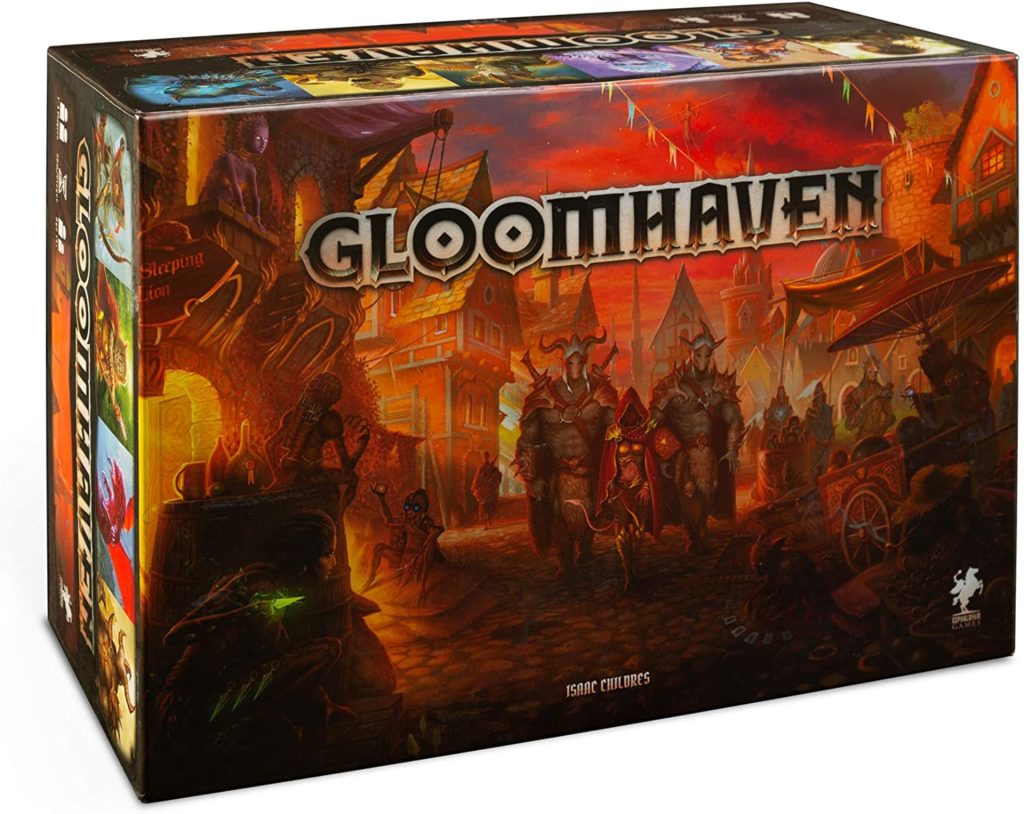Culture Club: Good Times in Gloomhaven

Drax Valarius found himself alone in the Frozen Hollows, facing the enemies before him. His comrades in the Adventurers had fled, abandoning their quest to recover a magical orb on behalf of Hail the Enchantress. Although Drax was a grey-furred manbeast built like a tank, he too was on the verge of giving up. With a desperate lunge, he swung his battle axe at the closest frost demon. Too exhausted to kill any more, he too ran for his life. Hobbling back to the town of Gloomhaven, Drax rejoined the Adventurers. As they nursed their wounds, they vowed to watch their stamina more closely and never make the same mistakes again.
The Adventurers, that’s us, my family and me. We chose the name for the group of heroes we’ve been playing in the boardgame Gloomhaven, our favorite indoor pastime during the long, cold weekends of this COVID-infested winter. My wife and six-year-old daughter play as Maeve and Iza Fireheart, a duo of ruthless human scoundrels. My ten-year-old son plays Vlad Goldentooth, a rodent-like Vermling who brainwashes enemies into fighting each other and summons giant rats. I, of course, am Drax, an Inox brute whose voice I roleplay with Hulk-like gusto: “Me Drax! Me smash!”
Isaac Childres designed Gloomhaven shortly after finishing his PhD in physics and ditching academia. Released in 2017, the game was showered with acclaim and almost immediately sold out despite a $150 price tag. By the time Childres released a second printing, Gloomhaven had been voted the #1 board game of all time on the authoritative website boardgamegeek.com, where it remains to this day. It’s now on its sixth printing and Childres has raised an astonishing $12 million on Kickstarter for its sequel, Frosthaven.
In game speak, Gloomhaven is a tabletop, deck-building, legacy, dungeon-crawler role-playing game. Translation: Gloomhaven is played on a table, with cards, a board and various pieces, as opposed to being a videogame. A key part of play includes constructing a deck of cards that impart specific abilities to the player’s character. Playing the game causes permanent “legacy” changes to the game’s world by opening new aspects of the game that persist in subsequent playthroughs. Gameplay largely consists of crawling through dungeons fighting monsters. Players role-play as characters with limited, although customizable, sets of abilities that level up over the course of the game, presenting engaging new ways to play.
Think: Dungeons and Dragons as a board game crossed with the card game Magic the Gathering. If this is still drawing a blank, think: a Choose Your Own Adventure book re-mixed into a cooperative board game. Players control a team of characters who undertake a massive sword-and-sorcery adventure in the lands surrounding Gloomhaven. Childres wrote over 95 (!) different, scripted scenarios for players to navigate, each leading from the last depending upon the choices they make.
Moment-to-moment gameplay unfolds through a combat system where players build decks of cards that allow them to perform moves against a variety of enemies in areas designed for each scenario, built from variously shaped board tiles. Scenarios feel less like actual combat, however, than puzzles, each building on previous solutions. Each scenario has its own goals and accompanying story, which furthers the game’s over-arching storyline.
A clever, easy-to-follow set of rules determines enemy moves. Instead of dice rolls, randomly drawn cards create uncertainty, allowing for emergent storytelling, as happened when the Adventurers failed their quest. Instead of dying, characters lose stamina and become exhausted. If all the characters do, the scenario fails and must be replayed. There are typically other, parallel scenarios to play, so players can come back later when they’re stronger and more experienced. Every scenario that the Adventurers have played has been a close call filled with enough tension that playing has occasionally spilled over into arguing. Our victories have been hard fought and satisfyingly well earned.
It takes our family two to three hours per scenario, plus about 45 minutes of setup and 15 minutes of cleanup. This means we’ll be playing for more than 200 hours if we play through the whole game. At that rate, it will easily take us a year to see most of what the game has to offer, and playing through once precludes certain paths, meaning that parts of the game are only accessible on multiple playthroughs. I knew we were in for a lot of game when the box arrived, weighing more than 20 pounds! I didn’t expect that we would be drawn so quickly into the challenges it has to offer. Even my wife, who’s not fond of games involving violent combat, has been hooked by the collective puzzle-solving. Playing Gloomhaven has been a welcome break for all of us from screen time.
As the Adventurers, we are indefatigable. After detouring through another scenario, we returned to Frozen Hollow and used new tactics to recover the orb. While we may not be able to combat the viruses lurking outside in the real cold air, for a while we’ve been able to gather in Gloomhaven and struggle with consequences no more severe than temporary exhaustion. That’s been a satisfying place to spend some time when things outside Gloomhaven’s fantasy realm have been so scary.
William Kaizen is an art historian and public art advocate. He chairs the Amherst Public Art Commission.
